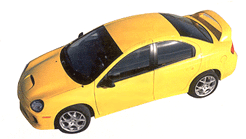
Hi:
When it debuted in 1994, the “cute and fast” Neon extended a friendly “Hi” to generation Xers with its 132-horsepower, 2.0-liter 4-cylinder engine.
- It’s a Gas Gas Gas:
The SRT-4 is an all grown up Neon that incorporates Street Racing & Technology (SRT). The SRT-4 shouts “WHASSUP!” with a powerful turbocharged, intercooled 2.4-liter DOHC 16-valve, 4-cylinder engine that produces 230 horsepower and 250 lb./ft. of torque.
- The Need for Speed:
The SRT-4 scoots from 0 to 60 mph in 5.8 seconds. Dodge ranks its performance second only to the Viper SRT-10.
- Contents May Shift During Flight:
The SRT-4 features an NVG T-850 heavy-duty 5-speed manual transmission. The heavy-duty clutch helps to route torque to equal-length half-shafts driving the front wheels.
- Struttin’ Your Stuff:
The SRT-4 sticks on the streets because it’s equipped with a fully independent front and rear suspension with gas-charged Tokico struts and stabilizer bars.
- Bright Lights, Big Colors:
Five colors light the streets like a neon sign: Flame Red, Electric Blue, Solar Yellow, Bright Silver Metallic and Black.
- It’s What’s On the Inside:
Most noteworthy is the pair of racing-style bucket seats with oversized thigh and torso bolsters – adapted from the buckets used in the Dodge Viper. (Honorary Mention: a 160-mph speedometer.)
- Deja vu:
The SRT-4 is a car with a short list of priorities, all of them performance-oriented. Chrysler used this formula once before on the Dodge Omni GLH (“Goes Like Hell”). Although the SRT-4 isn’t nearly as hard-edged (remember the GLH’s self-centering steering that went AWOL when you applied power in a curve?), the two vehicles do share one similarity: In its day, the GLH was the most bang for your buck. At $20,995, so is the SRT-4.
Writer Bob Bissler is senior editor of BodyShop Business.













